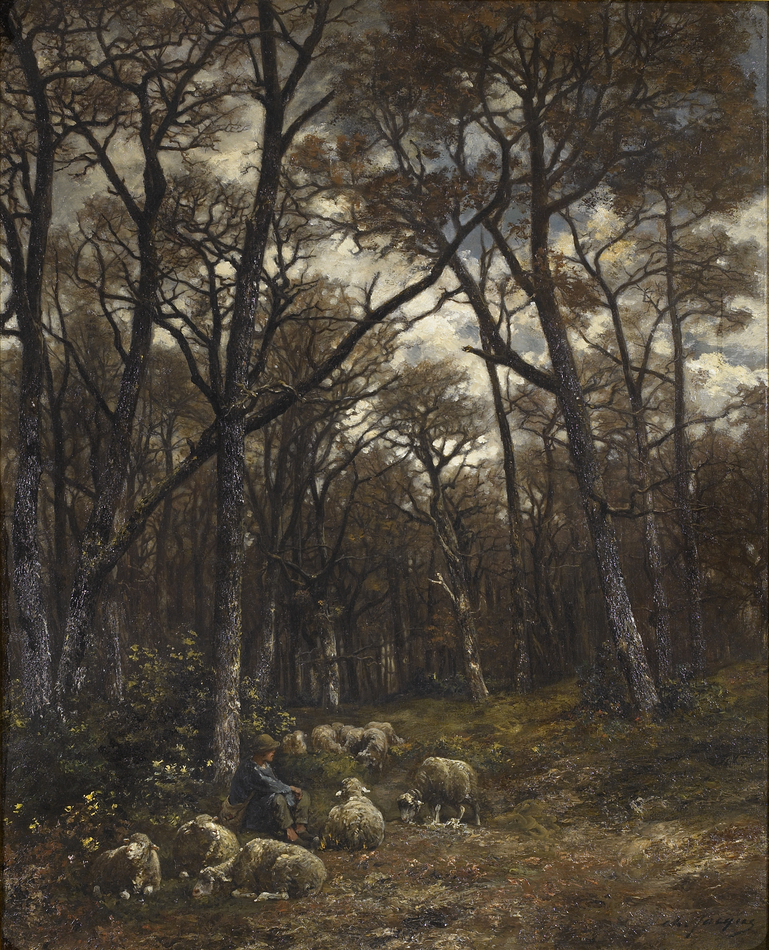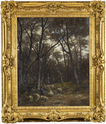Shepherd and flock in a moonlit forest
Signed lower right: Ch. Jacque
Provenance:
Thomas McLean Gallery, London, before 1922
Private Collection, Boston
Charles Jacque was among the first generation of painters to leave the city for Barbizon and the forest of Fontainebleau, where helped to establish the Barbizon School. Also a founding and influential member of the ?Men of 1830? (also called l?Ecole francaise du paysage), a loose movement of artists who, spurred on by the Revolution of 1830, sought out new directions in landscape painting. His strong, realistic, yet sensitive depictions of shepherds and their flocks form one of the most cohesive and important bodies of work produced by the movement.
Born in 1813 in Paris, Jacque began his training in etching rather than painting, as an apprentice to a map engraver. In this area, Jacque was unsurpassed among his colleagues in the Barbizon school. After military service, he went to England, where he worked as an engraver for La Charivari. Returning to France after two years abroad, he made his Salon debut in 1833 and regularly contributed paintings every year until 1870. Winning medals for both etching and painting, he was awarded the Legion d?honneur in 1867.
During the 1840s, he and his friend, Jean-Francois Millet moved to the village of Barbizon where they felt they could more realistically portray nature. Jacque bought a house there and, influenced by Diaz?s technique and Millet?s themes, found his inspiration in hen-houses, pigsties and flocks of sheep at pasture. He was also involved in non-artistic activities, such as land speculation and poultry breeding, about which he wrote a book, Le Poulailler, monographie des poules indigènes et exotiques, published in 1848. He left Barbizon in 1854 and continued to paint in the outskirts of Paris until he died on May 7, 1894.
Selected Museum Collections:
Amsterdam, Stedelijk; Baltimore Museum of Art; Boston, Isabella Stewart Gardner Museum; Budapest, Museum of Fine Art.; Cincinnati Museum of Fine Art; Edinburgh, National Gallery of Scotland; Glasgow Museum of Art; Kansas City, MO, Nelson-Atkins Museum of Art; Milwaukee, Layton Art Gallery; Minneapolis Institute of Arts; Muncie, IN, Ball State University Art Gallery; New York, Metropolitan Museum of Art & Brooklyn Museum; Northampton, MA, Smith College Museum of Art; Oxford, England, Ashmolean Museum, Oxford University; Philadelphia Museum of Art, John G. Johnson Collection; Museum of Quebec; Saint Petersburg, Hermitage Museum; Seattle, Henry Art Gallery; Southampton Art Gallery, England; Williamstown, MA, Sterling and Francine Clark Art Institute; Paris, Louvre, Musée d?Orsay; The Hague, Netherlands; Reims Musée des Beaux-Arts;
Select Bibliography:
Fanica, Pierre-Olivier. Charles Jacque, 1813-1894, Graveur original et peintre animalier. Art Bizon, Montigny-sur-Loing, 1995.
Herbert, Robert. Barbizon Revisited. Museum of Fine Arts, Boston, 1962.
Jones, Kimberly A. In the Forest of Fontainebleau. National Gallery of Art, Washington and Yale University Press, New Haven and London, 2008.
Request more information
News on the artist
-
The Clark has an exhibition of British & French landscapes, including #Barbizon painters #Rousseau, #Dupré, and #Troyon. http://t.co/JEEym3mJuly 27, 2011 @ 2:40 PM UTC
-
Now in Glasgow: #Millet #Barbizon Pastel of "The Angelus" Allocated to Kelvingrove Art Gallery and Museum: http://t.co/soF2LMA via @AddThisAugust 1, 2011 @ 3:35 PM UTC
-
Barbizon artist #Jacque was an expert and author on chicken farming and here is his major treatise with illustrations: http://t.co/lfhCUrEAugust 10, 2011 @ 6:26 PM UTC
-
See the great-grandfather of French landscape painting @AshmoleanMuseum: http://t.co/3KFFPXqu #Barbizon #exhibitionsOctober 6, 2011 @ 3:00 PM UTC
-
National Gallery of Art to reopen 19th-century French galleries in January: http://t.co/2HcCfSuF #Academic #PostImpressionist #BarbizonOctober 20, 2011 @ 9:17 PM UTC
-
Masterpieces from the Musée d'Orsay on view in Asia: http://t.co/xNhXdBgT #Realism #Barbizon #Academic #Impressionism #exhibitionsNovember 1, 2011 @ 3:38 PM UTC
-
Take a photo tour of @MuseeOrsay new Impressionist galleries: http://t.co/gmVlnx5n @artinfodotcom #Academic #Impressionism #BarbizonNovember 3, 2011 @ 4:34 PM UTC
-
Städel Museum to open Claude #Lorraine exhibition in February 2012: http://t.co/rA5Z1eTr via @AddThis #exhibitionsIwishIcouldsee #BarbizonDecember 12, 2011 @ 10:53 PM UTC
-
When you visit the new 19th-century galleries @ngadc don't miss this #Rousseau http://t.co/Qgr6EWp5 and http://t.co/awPyBEDl #BarbizonJanuary 30, 2012 @ 10:42 PM UTC
-
http://t.co/xkAzAOwi - Would #Renoir be the same had he not met #DiazdelaPena in #Barbizon in 1862 and come under his influence?February 7, 2012 @ 10:14 PM UTC
-
March 16, 2012 @ 7:56 PM UTC
-
Google expands Art Project to 150+ #museums http://t.co/SFjJl9UI Here is an early #Corot @philamuseum http://t.co/M6AuUwof #BarbizonApril 10, 2012 @ 2:50 PM UTC
-
Paradises & Landscapes in the Thyssen Coll. opens in Málaga: http://t.co/bS54sQ4n #Barbizon #PostImpressionist #Impressionism #exhibitionsApril 10, 2012 @ 3:09 PM UTC
-
April 13, 2012 @ 9:22 PM UTC
-
Happy Birthday Jules #Dupre April 15, 1811 (same day as Theordore #Rousseau!) http://t.co/Vq4MBTrD #BarbizonApril 13, 2012 @ 9:23 PM UTC
-
Baroness Carmen Thyssen Bornemisza to sell "The Lock" by John #Constable at Christie's: http://t.co/qdMksw47 #Academic #BarbizonMay 30, 2012 @ 7:40 PM UTC
-
Shame that this is leaving the @museothyssen - Protest in Spain at sale of #Constable 's 'The Lock' http://t.co/xFY0yAKn #museums #BarbizonJuly 2, 2012 @ 4:03 PM UTC
-
July 16, 2012 @ 8:01 PM UTC
-
August 29, 2012 @ 10:26 PM UTC
-
#Courbet 's Majestic Oak Painting Returns to Its Roots After Hometown Museum's $5-Million Purchase http://t.co/y2JTiZXo #Barbizon #RealismSeptember 7, 2012 @ 3:07 PM UTC
-
Musee d'Orsay opens major show of 19th-cty paintings at new Shanghai museum http://t.co/DE9KXjtE #Barbizon #Naturalism #CourbetNovember 19, 2012 @ 10:19 PM UTC
-
French #Romantic, #Realist, #Barbizon and #Impressionist drawings on view at National Gallery of Art, Washington http://t.co/lxq8IPwUJanuary 28, 2013 @ 11:44 PM UTC
-
February 14, 2013 @ 4:00 PM UTC
-
#Courbet 's Modernity - lecture by Jack Flam at the NY Studio School tomorrow! http://t.co/OPWboSvmWK #Barbizon #RealismMarch 12, 2013 @ 3:27 PM UTC
-
Jacquemart-André Museum in Paris opens exhibition devoted to Eugène #Boudin http://t.co/FUAqaF7MGn #Barbizon #exhibitionsIwishIcouldseeMarch 21, 2013 @ 2:55 PM UTC
-
Tim Marlow on TEFAF's Treasures on Sotheby's Blog includes #Constable #Delacroix #Gericault http://t.co/Z82FXz1Lul #Barbizon #RomanticismMarch 22, 2013 @ 9:14 PM UTC
-
Happy belated bday Theodore #Rousseau http://t.co/7UrhiBahm6 and Jules #Dupre http://t.co/ATFe97j3cs. Apr 15 -a great day for #Barbizon artApril 16, 2013 @ 4:05 PM UTC
-
June 10, 2013 @ 3:41 PM UTC
-
Now at Schiller & Bodo : MASTERWORKS OF THE BARBIZON SCHOOL, on view through November 27 http://t.co/pgDhaUAscc #Barbizon #exhibitionsNovember 5, 2013 @ 4:10 PM UTC
-
April 15, 2014 @ 5:33 PM UTC
-
And Happy Birthday Jules #Dupre - April 15, 1811 - a great day for #Barbizon School painters! http://t.co/62PKvhJpN8April 15, 2014 @ 7:03 PM UTC
-
Take a look at this #Diaz from the 1904 #WorldsFair at the @kemperartmuseum in St. Louis. http://t.co/n2h0vSI9Fw #BarbizonMay 1, 2014 @ 3:35 PM UTC
-
Here is our current #exhibition catalogue: A Romantic Vision, The #Barbizon School and its Contemporaries http://t.co/iemkJ4fmdGMay 5, 2015 @ 5:16 PM UTC
-
300 years of French landscape painting at the Toledo Museum of Art, including #Rousseau #Courbet #Daubigny http://t.co/j21mPIWRc4 #BarbizonAugust 11, 2015 @ 2:52 PM UTC
-
#Daubigny, Monet, Van Gogh: Impressions of Landscape is open now at the Taft Museum of Art- https://t.co/8BlaBpUD0P #Barbizon #ImpressionismMarch 10, 2016 @ 5:50 PM UTC
-
Rediscovering #Daubigny , an Unsung Influence on the Impressionists https://t.co/nPa7zTFG4d #Impressionism #BarbizonMarch 15, 2016 @ 3:01 PM UTC
-
Happy Birthday Théodore #Rousseau , born April 15, 1812 : https://t.co/lJZexdfYUU #Barbizon #artistbirthdaysApril 15, 2016 @ 7:09 PM UTC
-
Opening Monday- Unruly Nature: The Landscapes of Théodore #Rousseau @ the Getty https://t.co/L9tATSW4sX #Barbizon #exhibitionsIwishIcouldseeJune 17, 2016 @ 8:23 PM UTC
-
Théodore #Rousseau Gets His Due at the Getty Museum https://t.co/MLe45ku6oS #Barbizon #exhibitionsIwishiIcouldseeJuly 15, 2016 @ 7:30 PM UTC
-
Opening at the @vangoghmuseum : #VanGogh #Rousseau #Corot: In the Forest : https://t.co/NSNvTW3bV5 #Barbizon #exhibitionsIwhiIcouldseeJuly 13, 2017 @ 9:49 PM UTC
-
Happy Birthday to Jean Francois #Millet, one of the original great #Barbizon painters, whose work has moved its aud… https://t.co/w7kqh3CTZZOctober 4, 2018 @ 5:43 PM UTC




